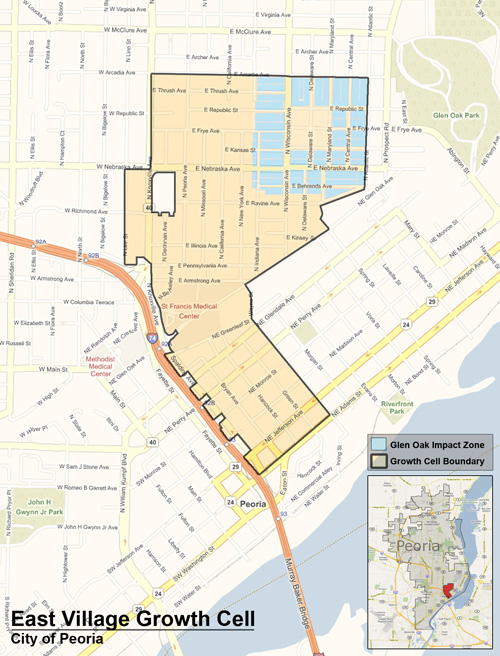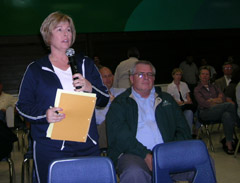The City of Peoria is taking steps toward establishing another growth cell and tax increment financing (TIF) district. There’s even a website devoted to it. The website is very informative; it includes a map, a frequently-asked-questions (FAQ) page, and a timeline.
Here’s a brief overview of what’s happening: The City has been using a “growth cell strategy” to expand and develop the north and west fringes of the City. They now want to “apply the City’s Growth Cell Strategy to the heart of the City; taking advantage of existing infrastructure and building upon existing public and private investment.” So, they’ve carved out the following area to redevelop:

As you can see, they’re calling this the “East Village Growth Cell.” Already, there is “increase[d] interest in redevelopment,” they say, as a result of the new Glen Oak School and Neighborhood Impact Zone, but “additional public guidance and intervention are needed to further spur growth within the area,” according to the website. So, they want to get this area designated as a “Redevelopment Project Area” and classified as a “blighted area” or “conservation area” so they can create a new TIF. The growth cell and TIF would be coterminous.
That’s it in a nutshell; there’s more information at www.EastVillagePeoria.com.
Of particular interest in this whole process, though, is OSF’s involvement. They’re putting up the money for the study, the website explains: “As one of the larger investors within the East Village, OSF has agreed to advance the cost for the Consultant that will be reimbursed to OSF out of first proceeds if, and only if, Council approves a redevelopment project.” And the Catholic Diocese (specifically Patricia Gibson, Chancellor/Diocesan Attorney) issued the following press release today:
On behalf of the Catholic Diocese of Peoria, I would like to express my overwhelming support for the proposed East Village Growth Cell. This creative and progressive initiative will advance the quality of life of individuals living in the study area and make essential improvements to our most historic and traditional neighborhoods.
Our most precious resources are the families who live throughout the City of Peoria. It’s particularly important that we engage these families throughout the process and demonstrate the City’s commitment to provide resources to reinvest and revitalize the heart of our community. This study area can be the stepping stones to a new beginning for the neighborhoods located within the East Village Growth Cell.
“The proposed study area will be a tremendous blessing to the Peoria community,” says Patricia Gibson, Chancellor/Diocesan Attorney. “The Catholic Diocese has made major investments within the proposed study area including the ongoing restoration of Spalding Institute and a new Pastoral Center. Additionally, St. Mary’s Cathedral and St. Bernard’s Parish are uniquely located within the proposed boundaries. We believe that this neighborhood will continue to grow and flourish, and we are confident that an investment of this magnitude will open the door to future development.”
OSF Saint Francis Medical Center has lead the way in providing the highest quality of health care for our city. They continue to show their commitment to the community with the expansion of their campus. We trust that the continued involvement of OSF will greatly enhance future development.
And the City of Peoria also issued a press release that quotes several community leaders; here’s part of it:
A new strategy will ensure that these projects are completed in a consistent manner, thereby becoming a catalyst for future investment.
On July 13, 2010, Members of the Peoria City Council will be asked to approve a request for proposals to conduct a study in the East Village Growth Cell. The study will determine if the area is eligible for redevelopment. A residential TIF has the potential to create opportunities for major improvements in the study area. This initiative marks the first time that the City of Peoria has done a study that includes housing.
“This could be a unique project in that it incorporates opportunities for residential re-development in the heart of one of our older neighborhoods. I believe the council will be anxious to see the study move forward and have an opportunity to discuss the findings. Perhaps it will generate a model we can use in other more mature areas of our city,” says Mayor Jim Ardis.
Development in the proposed East Village Growth Cell will compliment the ventures currently undertaken in the area, including investments by OSF Saint Francis Medical Center and District 150 in the surrounding neighborhood. The study will also provide the opportunity to develop businesses within the Growth Cell.
The East Village Growth Cell presents an opportunity for a major collaboration between Peoria School District 150, OSF Saint Francis Medical Center, and the City of Peoria.
Dr. Grenita Lathan, Superintendent of Peoria Public Schools said, “We look forward to partnering with the City and OSF on this potential growth opportunity for Glen Oak School and the surrounding neighborhoods.”
“OSF Saint Francis Medical Center is pleased to support the East Village redevelopment project. We believe the stabilization of the neighborhood and the increase in home ownership will have a positive impact on the area,” says Sue Wozniak, Chief Operating Officer, OSF Saint Francis Medical Center.
The study area has the potential to provide for future growth, improvements to the surrounding neighborhoods, and redevelopment of affordable housing.
So, let’s see, the Mayor, the D150 Superintendent, the OSF COO . . . . I do believe this is a highly coordinated effort. All these press releases, the website, a surprise public meeting with residents, and the City Council agenda came out on the same day at the same time. Sounds like yet another deal that has been brokered behind closed doors and rolled out to the public with great fanfare, ala the Wonderful Development.
I hate to be cynical, but this just looks like a typical “done deal” with public input solicited after the fact for window dressing. It bothers me that there’s been so much apparent coordination by public officials out of the public’s eye. The public doesn’t have much time to look into this project before the City votes on pursuing it. That’s generally how the Council likes it.

 I attended the first of four public forums hosted by District 150 last night. This one was held at Woodruff High School. The school board is trying to convince the public that they’re listening and seriously considering public input in the siting of a new school for the Woodruff attendance area.
I attended the first of four public forums hosted by District 150 last night. This one was held at Woodruff High School. The school board is trying to convince the public that they’re listening and seriously considering public input in the siting of a new school for the Woodruff attendance area. The Journal Star provides on their website a copy of the
The Journal Star provides on their website a copy of the  On WCBU (89.9 FM) tonight, they aired a half-hour interview with outgoing District 150 School Board member Garrie Allen. They touched on many topics, but I was particularly interested in his remarks about the Glen Oak School controversy.
On WCBU (89.9 FM) tonight, they aired a half-hour interview with outgoing District 150 School Board member Garrie Allen. They touched on many topics, but I was particularly interested in his remarks about the Glen Oak School controversy.